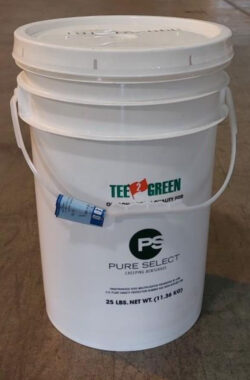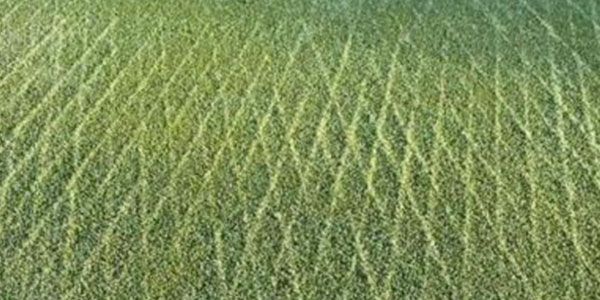Establishing a mature, permanent, and high-quality turfgrass stand in the shortest time possible is the goal of any seeding. The process typically begins with soil modification (including grading) to ensure proper surface water drainage, applying topsoil, and incorporating appropriate amendments (based on soil test results) such as fertilizers and lime. This is then followed by selecting recommended turfgrass species, cultivars, and mixtures or blends, planting the seeds, and of course, administering proper post-planting care.
Seed labels and seed quality
While all of the steps above are important, one stands out as critical. Purchasing high-quality seed is the single most important investment in ensuring high-quality turf. When purchasing seed, it’s extremely important to know seed label terminology and definitions so you can understand and interpret seed tag analysis information. For example, purchasing outdated seed, seed containing high weed content, or seed mixtures containing undesirable species or varieties can significantly increase the odds your project will fail. The seed analysis tag is your ticket to knowing exactly what is contained inside the seed package.

Know what you’re buying…
By federal law, the following information must be listed on the seed analysis tag:
- The name of the seller: On the sample seed label, Tee-2-Green is the seller.
- Lot number: Maintain a record of all seed analysis tags because they contain the name of the seller (supplier) and lot number. The supplier’s name is useful if the same seed is to be reordered. The lot number is also useful to have. Should a problem develop, the supplier will be able to more accurately track vital seed information aboutthe origin of the seed using the lot identification number listed on the seed analysis label.
- The seed variety or varieties: On the sample seed label, Pure Select Creeping Bentgrass is the variety. Scientific names of grasses may be listed, but are not required.
- Purity: Purity is the percent by weight of each seed component (variety or species) in a mixture as expressed on the seed analysis tag or label. Purity is not necessarily an indication of “seed quality” but rather is a measure of “seed quantity.”
- Germination percentage: Germination is expressed on the seed label as the percentage of pure seed that is capable of growth. This value is determined according to strict laboratory procedures that are near “ideal conditions” in terms of temperature and moisture for germination compared to typical field conditions. Therefore, germination percentages indicated on the seed analysis tag do not necessarily reflect the percentage of seed that would be expected to survive the less-than-ideal conditions in the field. Germination declines with the age of the seed, with most grasses declining super fast. Bentgrass will hold its germ longer than most if stored correctly. Bentgrass that is stored in a cool dark location in the shop can last years. It is not unusual for 5- to 6-year-old bentgrass to still germinate at 90%. Better quality bentgrass, like Tee-2-Green’s products, have higher germination than others on the market due to the quality of growers and cleaners.
- Date: The date on which the seed was officially tested. Germination percentage declines with the age of the seed.
- Crop seed content: Crop seed content is the percent by weight of all seeds identified in the container as an “agricultural crop.” These must be specified by name if in excess of .5% by weight. Crop seed content can be more undesirable than some weed seeds as a source of contamination.
- Weed seed: The percent by weight of all seeds in the container which have not been identified as either pure seed or crop seed. This value should be as low as possible, ideally 0.25% or less.
- Noxious weeds: Expressed on the label as the number per pound or per ounce found in the seed lot. Weeds classified as noxious can vary by state and are considered undesirable because these weeds are difficult to manage even with proper chemical and cultural practices. For example, Poa annua (annual bluegrass) is considered a noxious weed in some states and none is permitted in seed certified as Sod Quality.
- Inert matter: The percent by weight of all material in the seed container that will not grow. Includes seed parts (broken seed, chaff), soil, and other inert material left over from cleaning operations. This value should be as low as possible since seed cost is based on bag weight, and inert material contributes to bag weight but does not contribute any value in terms of seed quality or purity.

Tee-2-Green sets the standard of higher quality seed that is rarely matched, due to the dedication of its growers. These highly skilled growers are second- or third-generation growers who have set their own standards above and beyond the Blue Tag standards. This means each bucket or bag you purchase from Tee-2-Green is the very best in quality.

Coated seed information
For superintendents who use coated seed, beware that the Analysis tag is created before coated treatment has been applied. Based on the percentage of coating applied, it will reflect the percentage of inert matter added to seed. You will also receive less seed by percentage of coating.
Coated seed will not pass Oregon or Tee-2-Green Blue Tag standards.
Example: Based on 50% coat
- 50% coating to bentgrass will add 50% percent inert matter
- If you buy 25lb of coated bentgrass, you will receive 12.5 lbs of bentgrass seed and 12.5 lbs of inert matter (coating)




